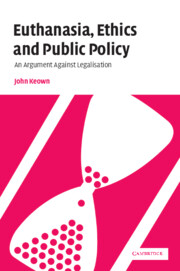Book contents
- Frontmatter
- Contents
- Preface
- Foreword
- Acknowledgments
- Table of cases
- List of abbreviations
- Introduction
- PART I Definitions
- PART II The ethical debate: human life, autonomy, legal hypocrisy, and the slippery slope
- PART III The Dutch experience: controlling VAE? condoning NVAE?
- PART IV Australia and the United States
- PART V Expert opinion
- 16 Expert committees
- 17 Supreme Courts
- 18 Medical associations
- PART VI Passive euthanasia: withholding/withdrawing treatment and tube-feeding with intent to kill
- Conclusions
- Afterword
- Bibliography
- Index
16 - Expert committees
Published online by Cambridge University Press: 20 July 2009
- Frontmatter
- Contents
- Preface
- Foreword
- Acknowledgments
- Table of cases
- List of abbreviations
- Introduction
- PART I Definitions
- PART II The ethical debate: human life, autonomy, legal hypocrisy, and the slippery slope
- PART III The Dutch experience: controlling VAE? condoning NVAE?
- PART IV Australia and the United States
- PART V Expert opinion
- 16 Expert committees
- 17 Supreme Courts
- 18 Medical associations
- PART VI Passive euthanasia: withholding/withdrawing treatment and tube-feeding with intent to kill
- Conclusions
- Afterword
- Bibliography
- Index
Summary
The House of Lords Select Committee
In 1993 in the wake of the controversy generated by the Bland case, the House of Lords (the upper chamber of the legislature as distinct from its Appellate Committee comprising the Law Lords) appointed an expert Select Committee to address issues raised by the case. A central issue the Committee was charged to consider was ‘whether and in what circumstances actions that have as their intention or a likely consequence the shortening of another person's life may be justified on the grounds that they accord with that person's wishes or with that person's best interests’. The Committee's terms of reference also required it ‘to pay regard to the likely effects of changes in law or medical practice on society as a whole’.
The Select Committee on Medical Ethics comprised fourteen members and was chaired by Lord Walton, an eminent physician and former President of the General Medical Council. The composition of the Committee suggested it might well be sympathetic to reform. Lady Warnock was a well-known liberal philosopher who had chaired a government committee which had recommended destructive research on human embryos in vitro. Lord Mustill was one of the Law Lords who had permitted the withdrawal of Tony Bland's tube-feeding. Only one member was confidently thought to be opposed to euthanasia: Lord Rawlinson, a Roman Catholic and former Attorney-General.
- Type
- Chapter
- Information
- Euthanasia, Ethics and Public PolicyAn Argument Against Legalisation, pp. 183 - 190Publisher: Cambridge University PressPrint publication year: 2002
- 1
- Cited by

